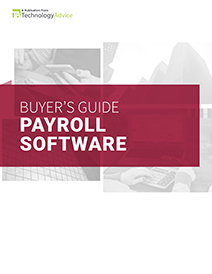You’ve made the decision. Spreadsheets and manual processes just aren’t cutting it anymore. It’s time to find a small business payroll solution that lets you pay your employees with ease, so you can spend more time doing what you do best: running your business.
That’s a smart decision, and one that more businesses are embracing, thanks to the expansion of the SaaS market. According to a 2014 Deloitte report, 56 percent of North American companies outsource their payroll technology hosting, maintenance, and support.
ALSO READ: 7 of the Best Payroll Management Tools for Your Business
Below are some tips for making a purchase decision that will support your business needs and provide positive ROI for years to come.
What to Look for in a Software Provider
There’s more to payroll software than features. When you buy or subscribe to a new solution, you’re also forming a relationship with the software provider. It’s important to make sure that provider offers the support and flexibility your business needs to grow.
Also Read: The Top Payroll Software For Enterprise And SMB
Here are few things things you should expect without question:
- Payroll software specifically designed for small businesses: You are not a Fortune 500 company, and you shouldn’t have to pay a fortune for payroll, especially when there are cloud-based payroll platforms that are more affordable. Payroll providers that specialize in small businesses are also more aware of your unique needs.
- Simple, transparent pricing: As a starting point, most small business payroll companies charge a base fee per pay cycle (each time you run payroll) combined with a dollar amount per employee. Other factors that affect pricing include the number of pay cycles you run per month. For example, weekly payroll would mean a minimum of four pay cycles per month. There may also be costs that are set by your payroll tax needs and the number of entities to which you report and remit. For an exact amount, speak with a sales rep to get an estimate.
- Excellent customer service: If you can’t ask questions, you can’t get answers. You’re going to trust this company with your payroll, the money you’ve set aside for your employees. If you don’t feel welcome, walk away.
- Flexibility: One size does not fit all, especially if you’re a small business. Make sure you feel like your payroll provider understands your needs and is willing to meet them. Try to find a provider that doesn’t require an annual contract, in case your situation changes or something goes wrong.
- Free trial: Most small business payroll providers also offer a 30-day free trial, meaning you can get set up, run a few pay cycles and “kick the tires” to make sure the software is right for you. Note: Getting set up means entering your employee information. Be prepared for a little hands-on onboarding at first.
Essential Small Business Payroll Features
Once you’ve narrowed your options to 3-5 of the best payroll software vendors that fit your criteria, you should look for these key features:
Direct deposit: There’s a beauty to having funds go directly into your employees’ bank accounts. In addition to the speed and convenience, there’s a lower risk of fraud, lost checks, and global deforestation.
Tax compliance: When you have employees, or even when you pay yourself, there are several payroll taxes to take into consideration, including income tax, social security, Medicare and other standard expenses. Payroll software helps automate this function by deducting and reporting the amounts, then paying (reporting) these funds to the appropriate federal, state and local tax authorities.
Reporting capabilities: Reporting goes hand in hand with tax compliance. Often, these same agencies require regular reporting of payment amounts. Reporting is also required at the end of the year, and it’s pretty helpful for keeping an eye on labor costs.
Employee access to pay stubs and W-2s: It’s a nice perk when employees can log in and review their pay stubs and W-2s on their own, without having to file a request.
Employee onboarding or termination: The right payroll software will make it simple to add or remove employees through an administrative panel.
Income types: Your small business payroll should allow for different types of income, including holiday pay, expense reimbursements, commission, bonuses and other taxable benefits.
Deduction types: The ability to deduct costs like medical, dental, vision and life insurance should also be on your checklist.
Contractor payments: A lot of small businesses use contractors. Your payroll software should be able to handle a 1099 and issue a paycheck with no withholding amounts.
Off-cycle payroll: You’d use this function to distribute bonuses, process an advance or final pay, or make a correction.
Also Read: How to Avoid These 3 Costly Payroll Mistakes
Final Considerations
There are a handful of “finishing touches” that can make a small business payroll tool above average, something your accountant/bookkeeper will enjoy vs. tolerate using. For starters, it should integrate with your accounting, invoicing and time-tracking systems. The TechnologyAdvice product review page for each payroll solution will likely mention key integrations. You can also learn more at each provider’s website.
You should look for a solution that provides “set-it-and-forget-it” functionality ‚Äî i.e. if you have a payroll that’s pretty straightforward and doesn’t change very often, you should be able to set it to run even when you’re on vacation. Similarly, automatic system updates provided by most cloud vendors will keep you from having to manually download and install new versions as they are released. This is also helpful when it comes to ever-changing rate tables.
Finally, your payroll provider’s capabilities need to match your geographic scope. If you operate in all 50 states, then you need to process payroll in all 50 states. If you have employees in Canada and the United States, you will want to consider software that’s compliant across North America.
* * *
By automating your payroll, you take a huge administrative burden off your shoulders, saving yourself time and the pain of mistakes. Seriously, you have better things to do than update overtime and tax tables. The right small business payroll software is like having your own expert on-hand. And because it’s virtual, it won’t drink all the coffee without making a new pot.
Michelle Mire is the content manager at Wagepoint, where she maintains a blog filled with expert payroll and small business advice.
Top Human Resources Software Recommendations


